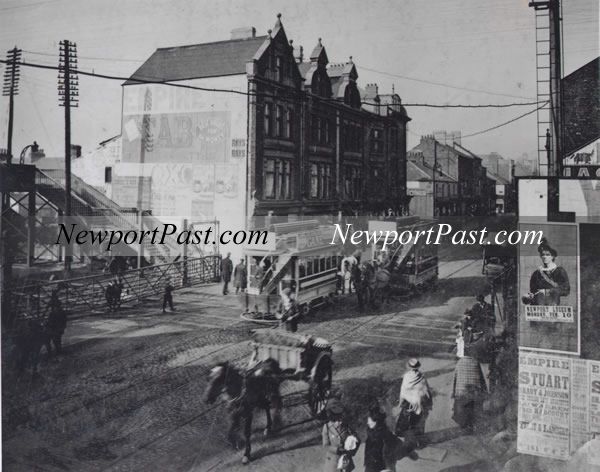Level Crossing Commercial Road - Pill Gates
 Photo reference number: 506
Photo reference number: 506
The level crossing near Albion Street and Frederick Street. Pre electric trams, probably 1902. Note the posters right of picture. The top one is advertising 'NEWPORT LYCEUM' Monday Feb.10 Matinee Saturday February 15', judging by the picture the production is Hamlet. (February 10th fell on a Monday in 1902 and 1896.) The lower poster is advertising the EMPIRE with 'Stuart the Male Patti, Brady and Johnson, The Chicago Lady Quartette, Lily? Warren, Fred Harcourt, Harry Rose, Esta Stella, ?? Terry & ?? Lambert...'
Two horse drawn trams are passing, the one heading away from us is tram 6.
From a private collection.
Since writing the above, I have come across the following article in the South Wales Argus from January 1976:
"Solved: case of the missing year
To look at this early photograph of a busy Newport street scene, you wouldn't guess that behind it lies an intriguing story of astute detective work.
But first, where was the photograph taken? No prizes offered for the correct answer, for most Newportonians, whether young or old, will recognise the Pill Gates in Commercial Road.
Next question: In which year was the photograph taken? In the absence of any record, even the curator of Newport Museum and Art Gallery (where the photograph is preserved) had to make a calculated guess.
The trouble was that it could be any year in a span of ten or more, but by taking into consideration such factors as the style of the dress of the women in the picture, he plumped for "circa 1900". As we shall see, he was not too far out, but still not sufficiently precise.
Enter, then, "Sherlock Holmes" in the guise of Mr. Edward Turnbull, evidently a man with an eye for clues that escape lesser men and a keen analytical mind to decipher them.
He lives in Gosforth, Northumberland. So how does someone living in the far north of England become involved in solving a Newport problem? Good question: I'll explain.
Playbills
In 1972, this photograph, in company with others of old Newport, found its way into a book called Victorian and Edwardian Wales from Old Photographs published nationally by Batsfords. Mr. Turnbull acquired a copy and while studying it, his discerning eyes were arrested by the photograph of Pill Gates, Newport, and the date "c. 1900" in the caption. Something else in the photograph caught his eye.
Writing to Mr. Cefni Barnett, curator of the museum, Mr. Turnbull pointed out: "On the extreme right of this picture two playbills are exhibited. The lower playbill refers to the Empire Theatre and advertises 'Stuart...' The upper playbill is of a figure with a label pasted over it reading 'Newport Lyceum, Monday, Feb. 10'. No name of actor or play is given, but the actor is in the traditional costume of Hamlet, in the 'Alas, poor Yorick' scene, where Shakespeare makes Hamlet point at Yorick's skull, which Hamlet holds in his other hand, as depicted in the Lyceum playbill."
(But "Holmes," I don't see... patience, the whole thing is quite elementary. Those are the clues: now to the deduction).
Evidence
"You will have noted already that it is possible to date the picture in your museum somewhat more precisely from such internal evidence, since any year with a Monday, February 10, in it — leap year of not — would, like 1975, itself having a Monday, February 10, be a year beginning on a Wednesday, January 1 and having the Dominical Letter 'E'. The perpetual calendar in the Oxford Companion to English Literature gives 1890, 1896 (leap year), 1902 and 1908 (leap year) all as beginning in this way, and it would be interesting to know if this helps you to date your museum's photograph more precisely.
Not only interesting, but fascinating. A slightly incredulous curator went straightway to the only possible source of confirmation - the early files of the South Wales Argus which are kept in the Central Library.
First he tried February 10, 1908. No luck. Next, the issue for Monday, February 10, 1902. "I could- hardly believe my eyes," says Mr. Barnett, "there were the two advertisements for the performances that week at the Empire and Lyceum Theatres, advertising the same shows as those on the playbills in the photograph."
Hamlet
At the Lyceum was a week's programme of Shakespeare's plays — The Merchant of Venice on Monday and Tuesday; Romeo and Juliet on Wednesday and Thursday, and Hamlet on Friday and Saturday.
The Empire, however, was operating on a slightly lower cultural level than the Lyceum; it was by now a "Palace of varieties." "Stuart," the top of the bill, whose name features so prominently on the playbill in the photograph was "America's soprano, the male Patti," and he (she?) was supported by a cast of comedians, jugglers, magicians, singers and dancers.
And so, as a result of Mr. Turnbull?s brilliant deduction, we now know that the photograph was taken in the week beginning Monday, February 10, 1902. We may not know the exact day, but Mr. Barnett thinks it was about ten o'clock in the morning, judging by the direction of the sun. This detection business is catching!
Carfax"